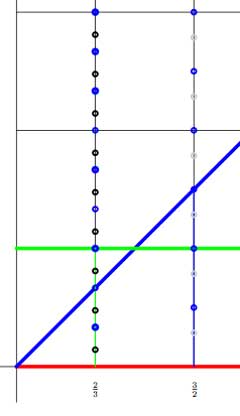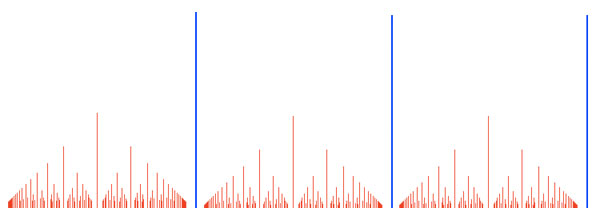Time to wrap up this series on the Bost-Connes algebra. Here’s what we have learned so far : the convolution product on double cosets
$\begin{bmatrix} 1 & \mathbb{Z} \\ 0 & 1 \end{bmatrix} \backslash \begin{bmatrix} 1 & \mathbb{Q} \\ 0 & \mathbb{Q}_{> 0} \end{bmatrix} / \begin{bmatrix} 1 & \mathbb{Z} \\ 0 & 1 \end{bmatrix} $
is a noncommutative algebra, the Bost-Connes Hecke algebra $\mathcal{H} $, which is a bi-chrystalline graded algebra (somewhat weaker than ‘strongly graded’) with part of degree one the group-algebra $\mathbb{Q}[\mathbb{Q}/\mathbb{Z}] $. Further, $\mathcal{H} $ has a natural one-parameter family of algebra automorphisms $\sigma_t $ defined by $\sigma_t(X_n) = n^{it}X_n $ and $\sigma_t(Y_{\lambda})=Y_{\lambda} $.
For any algebra $A $ together with a one-parameter family of automorphisms $\sigma_t $ one is interested in KMS-states or Kubo-Martin-Schwinger states with parameter $\beta $, $KMS_{\beta} $ (this parameter is often called the ‘invers temperature’ of the system) as these are suitable equilibria states. Recall that a state is a special linear functional $\phi $ on $A $ (in particular it must have norm one) and it belongs to $KMS_{\beta} $ if the following commutation relation holds for all elements $a,b \in A $
$\phi(a \sigma_{i\beta}(b)) = \phi(b a) $
Let us work out the special case when $A $ is the matrix-algebra $M_n(\mathbb{C}) $. To begin, all algebra-automorphisms are inner in this case, so any one-parameter family of automorphisms is of the form
$\sigma_t(a) = e^{itH} a e^{-itH} $
where $e^{itH} $ is the matrix-exponential of the nxn matrix $H $. For any parameter $\beta $ we claim that the linear functional
$\phi(a) = \frac{1}{tr(e^{-\beta H})} tr(a e^{-\beta H}) $
is a KMS-state.Indeed, we have for all matrices $a,b \in M_n(\mathbb{C}) $ that
$\phi(a \sigma_{i \beta}(b)) = \frac{1}{tr(e^{-\beta H})} tr(a e^{- \beta H} b e^{\beta H} e^{- \beta H}) $
$= \frac{1}{tr(e^{-\beta H})} tr(a e^{-\beta H} b) = \frac{1}{tr(e^{-\beta H})} tr(ba e^{-\beta H}) = \phi(ba) $
(the next to last equality follows from cyclic-invariance of the trace map).
These states are usually called Gibbs states and the normalization factor $\frac{1}{tr(e^{-\beta H})} $ (needed because a state must have norm one) is called the partition function of the system. Gibbs states have arisen from the study of ideal gases and the place to read up on all of this are the first two chapters of the second volume of “Operator algebras and quantum statistical mechanics” by Ola Bratelli and Derek Robinson.
This gives us a method to construct KMS-states for an arbitrary algebra $A $ with one-parameter automorphisms $\sigma_t $ : take a simple n-dimensional representation $\pi~:~A \mapsto M_n(\mathbb{C}) $, find the matrix $H $ determining the image of the automorphisms $\pi(\sigma_t) $ and take the Gibbs states as defined before.
Let us return now to the Bost-Connes algebra $\mathcal{H} $. We don’t know any finite dimensional simple representations of $\mathcal{H} $ but, sure enough, have plenty of graded simple representations. By the usual strongly-graded-yoga they should correspond to simple finite dimensional representations of the part of degree one $\mathbb{Q}[\mathbb{Q}/\mathbb{Z}] $ (all of them being one-dimensional and corresponding to characters of $\mathbb{Q}/\mathbb{Z} $).
Hence, for any $u \in \mathcal{G} = \prod_p \hat{\mathbb{Z}}_p^{\ast} $ (details) we have a graded simple $\mathcal{H} $-representation $S_u = \oplus_{n \in \mathbb{N}_+} \mathbb{C} e_n $ with action defined by
$\begin{cases} \pi_u(X_n)(e_m) = e_{nm} \\ \pi_u(Y_{\lambda})(e_m) = e^{2\pi i n u . \lambda} e_m \end{cases} $
Here, $u.\lambda $ is computed using the ‘chinese-remainder-identification’ $\mathcal{A}/\mathcal{R} = \mathbb{Q}/\mathbb{Z} $ (details).
Even when the representations $S_u $ are not finite dimensional, we can mimic the above strategy : we should find a linear operator $H $ determining the images of the automorphisms $\pi_u(\sigma_t) $. We claim that the operator is defined by $H(e_n) = log(n) e_n $ for all $n \in \mathbb{N}_+ $. That is, we claim that for elements $a \in \mathcal{H} $ we have
$\pi_u(\sigma_t(a)) = e^{itH} \pi_u(a) e^{-itH} $
So let us compute the action of both sides on $e_m $ when $a=X_n $. The left hand side gives $\pi_u(n^{it}X_n)(e_m) = n^{it} e_{mn} $ whereas the right-hand side becomes
$e^{itH}\pi_u(X_n) e^{-itH}(e_m) = e^{itH} \pi_u(X_n) m^{-it} e_m = $
$e^{itH} m^{-it} e_{mn} = (mn)^{it} m^{-it} e_{mn} = n^{it} e_{mn} $
proving the claim. For any parameter $\beta $ this then gives us a KMS-state for the Bost-Connes algebra by
$\phi_u(a) = \frac{1}{Tr(e^{-\beta H})} Tr(\pi_u(a) e^{-\beta H}) $
Finally, let us calculate the normalization factor (or partition function) $\frac{1}{Tr(e^{-\beta H})} $. Because $e^{-\beta H}(e_n) = n^{-\beta} e_n $ we have for that the trace
$Tr(e^{-\beta H}) = \sum_{n \in \mathbb{N}_+} \frac{1}{n^{\beta}} = \zeta(\beta) $
is equal to the Riemann zeta-value $\zeta(\beta) $ (at least when $\beta > 1 $).
Summarizing, we started with the definition of the Bost-Connes algebra $\mathcal{H} $, found a canonical one-parameter subgroup of algebra automorphisms $\sigma_t $ and computed that the natural equilibria states with respect to this ‘time evolution’ have as their partition function the Riemann zeta-function. Voila!
2 Comments The left cosets $\Gamma / \Gamma_0 $ are the subsets $\gamma \Gamma_0 $ with $\gamma \in \Gamma $. But,
The left cosets $\Gamma / \Gamma_0 $ are the subsets $\gamma \Gamma_0 $ with $\gamma \in \Gamma $. But,
